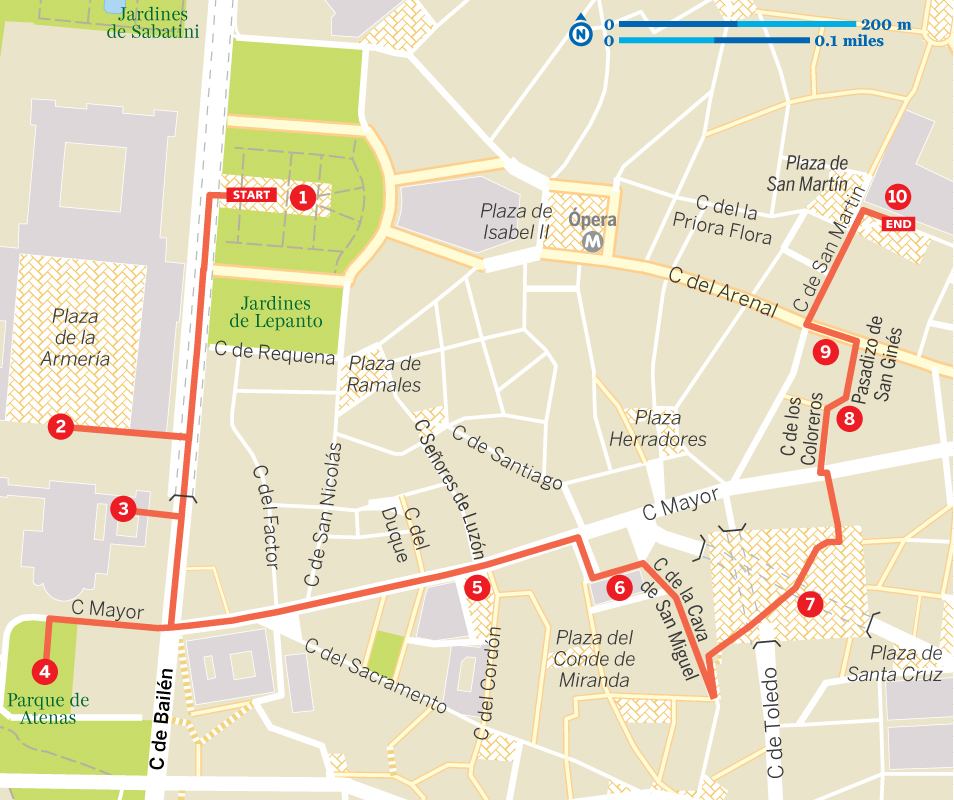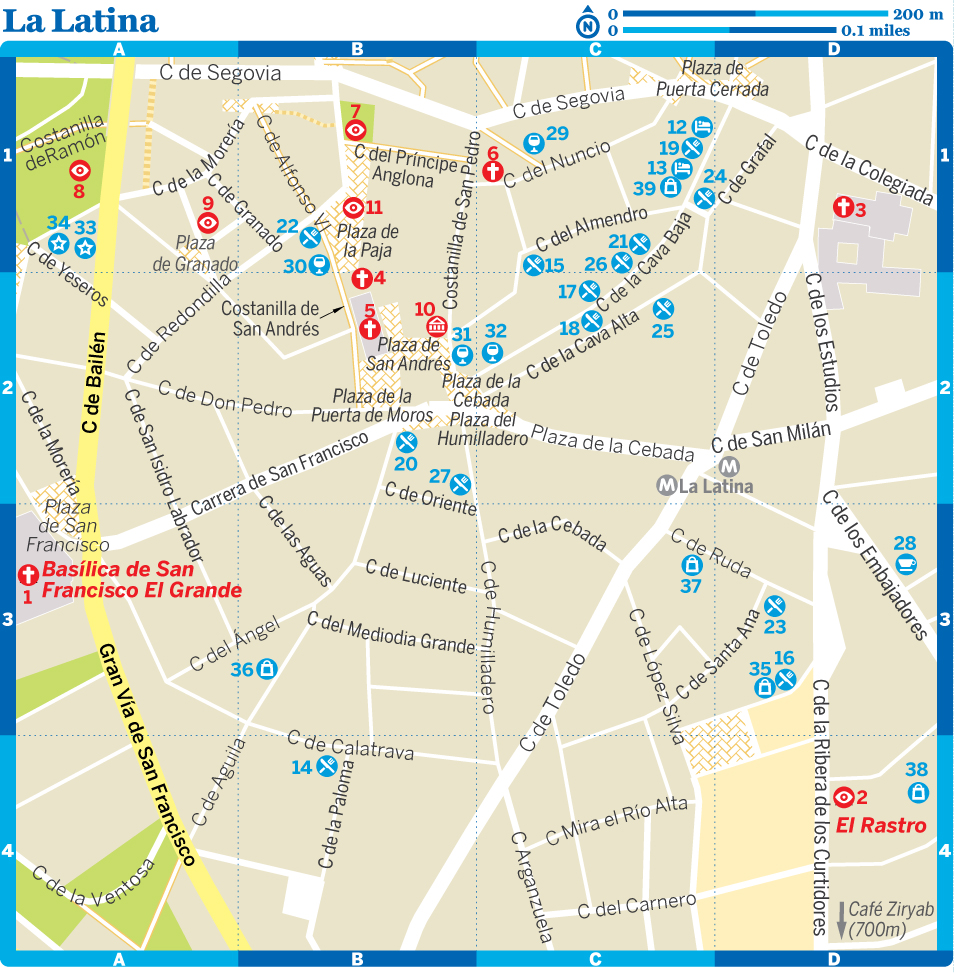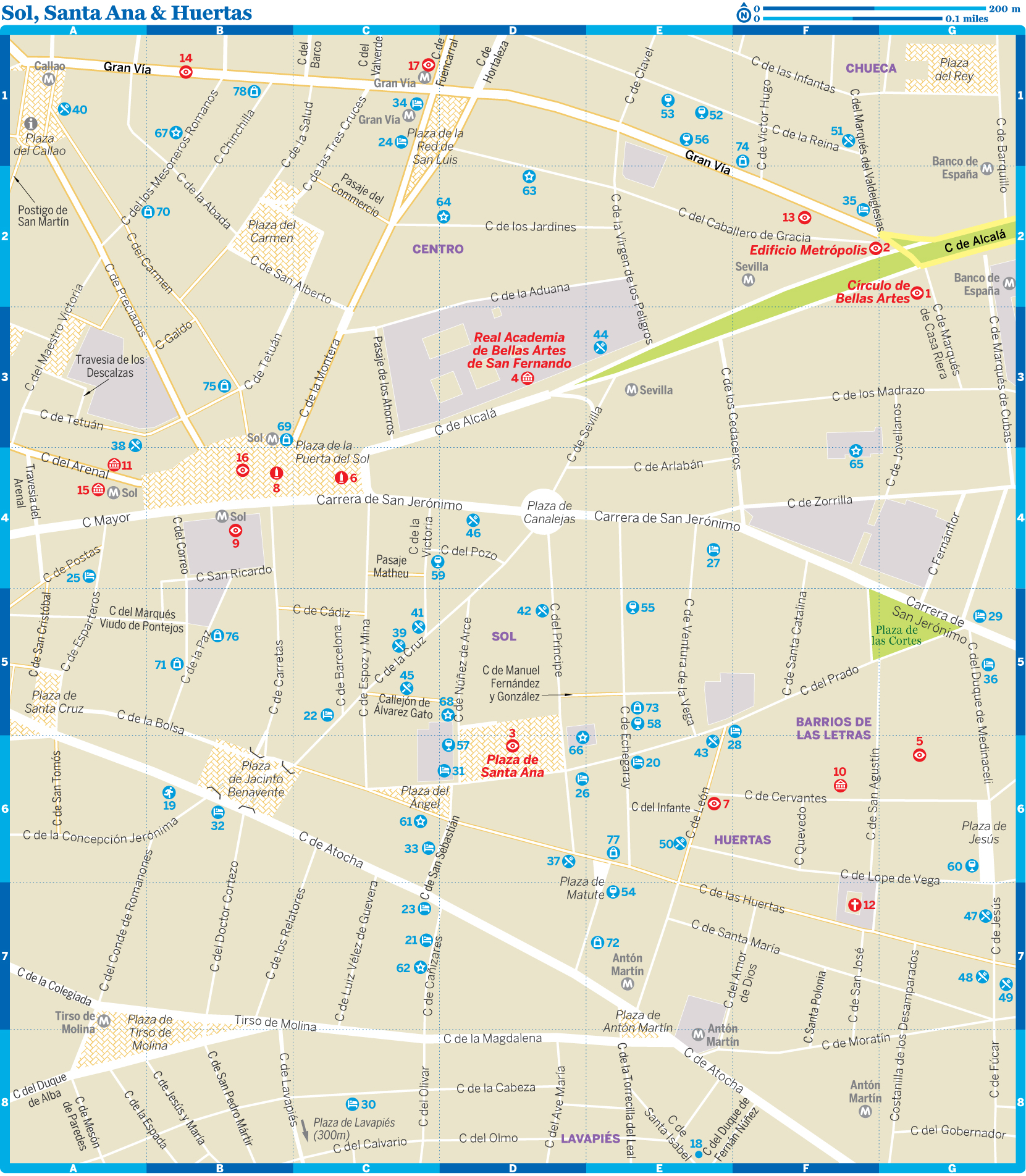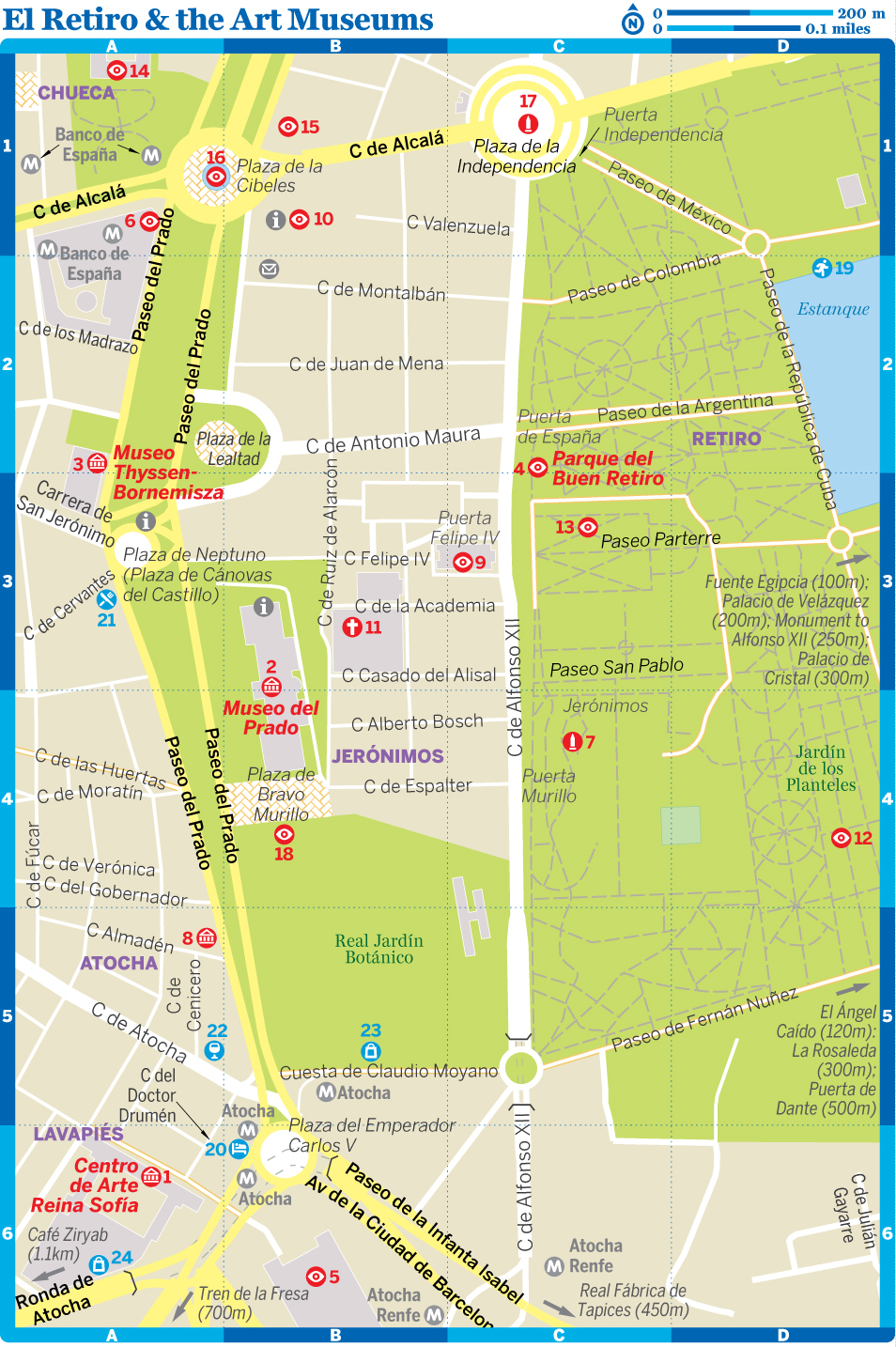![]() oPalacio Real PALACE
oPalacio Real PALACE
(MAP GOOGLE MAP; ![]() %91 454 88 00; www.patrimonionacional.es; Calle de Bailén; adult/concession €11/6, guide/audioguide €4/3, EU citizens free last 2hr Mon-Thu;
%91 454 88 00; www.patrimonionacional.es; Calle de Bailén; adult/concession €11/6, guide/audioguide €4/3, EU citizens free last 2hr Mon-Thu; ![]() h10am-8pm Apr-Sep, to 6pm Oct-Mar;
h10am-8pm Apr-Sep, to 6pm Oct-Mar; ![]() mÓpera)
mÓpera)
Spain’s lavish Palacio Real is a jewel box of a palace, although it’s used only occasionally for royal ceremonies; the royal family moved to the modest Palacio de la Zarzuela years ago.
When the alcázar (muslim fortress) burned down on Christmas Day 1734, Felipe V, the first of the Bourbon kings, decided to build a palace that would dwarf all its European counterparts. Felipe died before the palace was finished, which is perhaps why the Italianate baroque colossus has a mere 2800 rooms, just one-quarter of the original plan.
The official tour (self-guided tours are also possible and follow the same route) leads through 50 of the palace rooms, which hold a good selection of Goyas, 215 absurdly ornate clocks, and five Stradivarius violins still used for concerts and balls. The main stairway is a grand statement of imperial power, leading to the Halberdiers’ rooms and to the sumptuous Salón del Trono (Throne Room), with its crimson-velvet wall coverings and Tiepolo ceiling. Shortly after, you reach the Salón de Gasparini, with its exquisite stucco ceiling and walls resplendent with embroidered silks.
Outside the main palace, visit the Farmacia Real (MAP GOOGLE MAP; Palacio Real) at the southern end of the patio known as the Plaza de la Armería (Plaza de Armas). Westwards across the plaza is the Armería Real (MAP GOOGLE MAP; Royal Armoury; www.patrimonionacional.es; Plaza de la Armería, Palacio Real; admission incl with Palacio Real entry; ![]() h10am-8pm Apr-Sep, to 6pm Oct-Mar), a shiny collection of weapons and armour, mostly dating from the 16th and 17th centuries.
h10am-8pm Apr-Sep, to 6pm Oct-Mar), a shiny collection of weapons and armour, mostly dating from the 16th and 17th centuries.
Plaza de Oriente SQUARE
(MAP GOOGLE MAP; Plaza de Oriente; ![]() mÓpera)
mÓpera)
A royal palace that once had aspirations to be the Spanish Versailles. Sophisticated cafes watched over by apartments that cost the equivalent of a royal salary. The Teatro Real, Madrid’s opera house and one of Spain’s temples to high culture. Some of the finest sunset views in Madrid… Welcome to Plaza de Oriente, a living, breathing monument to imperial Madrid.
At the centre of the plaza, which the palace overlooks, is an equestrian statue of Felipe IV (MAP GOOGLE MAP; ![]() mÓpera). Designed by Velázquez, it’s the perfect place to take it all in, with marvellous views wherever you look. If you’re wondering how a heavy bronze statue of a rider and his horse rearing up can actually maintain that stance, the answer is simple: the hind legs are solid, while the front ones are hollow. That idea was Galileo Galilei’s. Nearby are some 20 marble statues, mostly of ancient monarchs. Local legend has it that these ageing royals get down off their pedestals at night to stretch their legs when no-one’s looking.
mÓpera). Designed by Velázquez, it’s the perfect place to take it all in, with marvellous views wherever you look. If you’re wondering how a heavy bronze statue of a rider and his horse rearing up can actually maintain that stance, the answer is simple: the hind legs are solid, while the front ones are hollow. That idea was Galileo Galilei’s. Nearby are some 20 marble statues, mostly of ancient monarchs. Local legend has it that these ageing royals get down off their pedestals at night to stretch their legs when no-one’s looking.
The adjacent Jardines Cabo Naval are a great place to watch the sunset.
Jardines de Sabatini GARDENS
(MAP GOOGLE MAP; ![]() h9am-10pm May-Sep, to 9pm Oct-Apr;
h9am-10pm May-Sep, to 9pm Oct-Apr; ![]() mÓpera)
mÓpera) ![]() F
F
The formal French-style Jardines de Sabatini are to the north of the Palacio Real, a palace with lush gardens.
Catedral de Nuestra Señora de la Almudena CATHEDRAL
(MAP GOOGLE MAP; ![]() %91 542 22 00; www.catedraldelaalmudena.es; Calle de Bailén; cathedral & crypt b1y donation, museum adult/child €6/4;
%91 542 22 00; www.catedraldelaalmudena.es; Calle de Bailén; cathedral & crypt b1y donation, museum adult/child €6/4; ![]() h9am-8.30pm Mon-Sat, museum 10am-2.30pm Mon-Sat;
h9am-8.30pm Mon-Sat, museum 10am-2.30pm Mon-Sat; ![]() mÓpera)
mÓpera)
Paris has Notre Dame and Rome has St Peter’s Basilica. In fact, almost every European city of stature has its signature cathedral, a standout monument to a glorious Christian past. Not Madrid. Although the exterior of the Catedral de Nuestra Señora de la Almudena sits in harmony with the adjacent Palacio Real, Madrid’s cathedral is cavernous and largely charmless within; its colourful, modern ceilings do little to make up for the lack of old-world gravitas that so distinguishes great cathedrals.
Muralla Árabe LANDMARK
(MAP GOOGLE MAP; Cuesta de la Vega; ![]() mÓpera)
mÓpera)
Behind the cathedral apse and down Cuesta de la Vega is a short stretch of the original ‘Arab Wall’, the city wall built by Madrid’s early-medieval Muslim rulers. Some of it dates as far back as the 9th century, when the initial Muslim fort was raised. Other sections date from the 12th and 13th centuries, by which time the city had been taken by the Christians.
Plaza de la Villa SQUARE
(MAP GOOGLE MAP; Plaza de la Villa; ![]() mÓpera)
mÓpera)
The intimate Plaza de la Villa is one of Madrid’s prettiest. Enclosed on three sides by wonderfully preserved examples of 17th-century barroco madrileño (Madrid-style baroque architecture – a pleasing amalgam of brick, exposed stone and wrought iron), it was the permanent seat of Madrid’s city government from the Middle Ages until recent years, when Madrid’s city council relocated to the grand Palacio de Cibeles on Plaza de la Cibeles.
On the western side of the square is the 17th-century former town hall (![]() mÓpera), in Habsburg-style baroque with Herrerian slate-tile spires. On the opposite side of the square is the Gothic Casa de los Lujanes (MAP GOOGLE MAP;
mÓpera), in Habsburg-style baroque with Herrerian slate-tile spires. On the opposite side of the square is the Gothic Casa de los Lujanes (MAP GOOGLE MAP; ![]() mÓpera), whose brickwork tower is said to have been ‘home’ to the imprisoned French monarch François I after his capture in the Battle of Pavia (1525). Legend has it that as the star prisoner was paraded down Calle Mayor, locals are said to have been more impressed by the splendidly attired Frenchman than they were by his more drab captor, the Spanish Habsburg emperor Carlos I, much to the chagrin of the latter. The plateresque (15th- and 16th-century Spanish baroque) Casa de Cisneros (MAP GOOGLE MAP; Plaza de la Villa;
mÓpera), whose brickwork tower is said to have been ‘home’ to the imprisoned French monarch François I after his capture in the Battle of Pavia (1525). Legend has it that as the star prisoner was paraded down Calle Mayor, locals are said to have been more impressed by the splendidly attired Frenchman than they were by his more drab captor, the Spanish Habsburg emperor Carlos I, much to the chagrin of the latter. The plateresque (15th- and 16th-century Spanish baroque) Casa de Cisneros (MAP GOOGLE MAP; Plaza de la Villa; ![]() mÓpera), built in 1537 with later Renaissance alterations, also catches the eye.
mÓpera), built in 1537 with later Renaissance alterations, also catches the eye.
Palacio Gaviria MUSEUM
(MAP GOOGLE MAP; ![]() %902 044226; Calle del Arenal 9; adult/child €12/free;
%902 044226; Calle del Arenal 9; adult/child €12/free; ![]() h10am-8pm Sun-Thu, to 9pm Fri & Sat;
h10am-8pm Sun-Thu, to 9pm Fri & Sat; ![]() mSol)
mSol)
Until recently this 19th-century Italianate palace was a nightclub. It has since been artfully converted to a dynamic artistic space, with major temporary art exhibitions that have included an Escher retrospective and the works of Alphonse Mucha. Coupled with high-quality exhibitions is a soaring Renaissance palace with extraordinary ceiling frescoes. Put all of this together and you’ve one of the more exciting additions to Madrid’s artistic portfolio.
Campo del Moro GARDENS
(MAP GOOGLE MAP; ![]() %91 454 88 00; Paseo de la Virgen del Puerto;
%91 454 88 00; Paseo de la Virgen del Puerto; ![]() h10am-8pm Apr-Sep, to 6pm Oct-Mar;
h10am-8pm Apr-Sep, to 6pm Oct-Mar; ![]() mPríncipe Pío)
mPríncipe Pío) ![]() F
F
These gardens beneath the Palacio Real were designed to mimic the gardens surrounding the palace at Versailles; nowhere is this more in evidence than along the east–west Pradera, a lush lawn with the Palacio Real as its backdrop. The gardens’ centrepiece, which stands halfway along the Pradera, is the elegant Fuente de las Conchas (Fountain of the Shells), designed by Ventura Rodríguez, the Goya of Madrid’s 18th-century architecture scene. The only entrance is from Paseo de la Virgen del Puerto.
Convento de las Descalzas Reales CONVENT
(MAP GOOGLE MAP; Convent of the Barefoot Royals; www.patrimonionacional.es; Plaza de las Descalzas 3; €6, incl Convento de la Encarnación €8; ![]() h10am-2pm & 4-6.30pm Tue-Sat, 10am-3pm Sun;
h10am-2pm & 4-6.30pm Tue-Sat, 10am-3pm Sun; ![]() mÓpera, Sol)
mÓpera, Sol)
The grim plateresque walls of the Convento de las Descalzas Reales offer no hint that behind the facade lies a sumptuous stronghold of the faith. The compulsory guided tour (in Spanish) leads you up a gaudily frescoed Renaissance stairway to the upper level of the cloister. The vault was painted by Claudio Coello, one of the most important artists of the Madrid School of the 17th century and whose works adorn San Lorenzo de El Escorial.
Iglesia de San Ginés CHURCH
(MAP GOOGLE MAP; Calle del Arenal 13; ![]() h8.45am-1pm & 6-9pm Mon-Sat, 9.45am-2pm & 6-9pm Sun;
h8.45am-1pm & 6-9pm Mon-Sat, 9.45am-2pm & 6-9pm Sun; ![]() mSol, Ópera)
mSol, Ópera) ![]() F
F
Due north of Plaza Mayor, San Ginés is one of Madrid’s oldest churches: it has been here in one form or another since at least the 14th century. What you see today was built in 1645 but largely reconstructed after a fire in 1824. The church houses some fine paintings, including El Greco’s Expulsion of the Moneychangers from the Temple (1614), which is beautifully displayed; the glass is just 6mm from the canvas to avoid reflections.
The church has stood at the centre of Madrid life for centuries. It is speculated that, prior to the arrival of the Christians in 1085, a Mozarabic community (Christians in Muslim territory) lived around the stream that later became Calle del Arenal and that their parish church stood on this site. Spain’s premier playwright Lope de Vega was married here and novelist Francisco de Quevedo was baptised in its font.
Convento de la Encarnación CONVENT
(MAP GOOGLE MAP; www.patrimonionacional.es; Plaza de la Encarnación 1; €6, incl Convento de las Descalzas Reales €8; ![]() h10am-2pm & 4-6.30pm Tue-Sat, 10am-3pm Sun;
h10am-2pm & 4-6.30pm Tue-Sat, 10am-3pm Sun; ![]() mÓpera)
mÓpera)
Founded by Empress Margarita de Austria, this 17th-century mansion built in the Madrid baroque style (a pleasing amalgam of brick, exposed stone and wrought iron) is still inhabited by nuns of the Augustine order. The large art collection dates mostly from the 17th century, and among the many gold and silver reliquaries is one that contains the blood of San Pantaleón, which purportedly liquefies each year on 27 July. The convent sits on a pretty plaza close to the Palacio Real.
Iglesia de San Nicolás de los Servitas CHURCH
(MAP GOOGLE MAP; ![]() %91 559 40 64; Plaza de San Nicolás 6;
%91 559 40 64; Plaza de San Nicolás 6; ![]() h8am-1.30pm & 5.30-8.30pm Mon, 8-9.30am & 6.30-8.30pm Tue-Sat, 9.30am-2pm & 6.30-9pm Sun & holidays;
h8am-1.30pm & 5.30-8.30pm Mon, 8-9.30am & 6.30-8.30pm Tue-Sat, 9.30am-2pm & 6.30-9pm Sun & holidays; ![]() mÓpera)
mÓpera)
Tucked away up the hill from Calle Mayor, this intimate little church is Madrid’s oldest surviving building of worship; it may have been built on the site of Muslim Mayrit’s second mosque. The most striking feature is the restored 12th-century Mudéjar bell tower; much of the remainder dates in part from the 15th century. The vaulting is late Gothic while the fine timber ceiling, which survived a 1936 fire, dates from about the same period. Opening hours can be unreliable.
Plaza de España SQUARE
(MAP GOOGLE MAP; ![]() mPlaza de España)
mPlaza de España)
It’s hard to know what to make of this curiously unprepossessing square. The square’s centrepiece is a 1927 statue of Cervantes with, at the writer’s feet, a bronze statue of his immortal characters Don Quijote and Sancho Panza. The 1953 Edificio de España (Spain Building) on the northeast side clearly sprang from the totalitarian recesses of Franco’s imagination such is its resemblance to austere Soviet monumentalism. To the north stands the 35-storey Torre de Madrid (Madrid Tower).
Palacio de Santa Cruz HISTORIC BUILDING
(MAP GOOGLE MAP; Plaza de la Provincia; ![]() mSol)
mSol)
Just off the southeastern corner of Plaza Mayor and dominating Plaza de Santa Cruz is this baroque edifice, which houses the Ministerio de Asuntos Exteriores (Ministry of Foreign Affairs) and hence can only be admired from the outside. A landmark with its grey slate spires, it was built in 1643 and initially served as the court prison.



